National symbols of Ireland, the Republic of Ireland and Northern Ireland

Symbols of Ireland are items or symbols that have symbolic meaning to, or represent, Ireland. Because Ireland was not partitioned until 1922, many of the symbols of Ireland predate the division into Southern Ireland (later Irish Free State and then Ireland) and Northern Ireland.
Unlike other countries (such as the United States, with the state symbols), Irish and Northern Irish state symbols are rarely defined by official Acts; they are defined by common usage or by various interest groups.
These symbols are seen in official capacities, such as flags, coats of arms, postage stamps, and currency, and in URLs.
They appear less formally as recurring themes in literature, art and folk art, heraldry, monuments, clothing, personal decoration, and as the names of parks, bridges and streets.
Insignia
Coat of arms
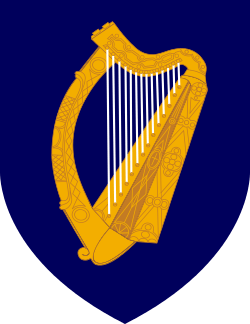
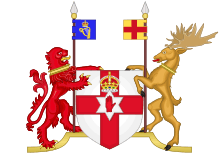
The arms of Ireland are a Celtic harp (cláirseach) on an azure field. Northern Ireland uses a much more complex arms; notable features are the Irish elk and the banner of the House of de Burgh.
Flags
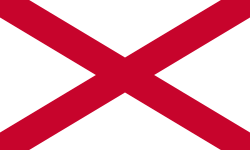

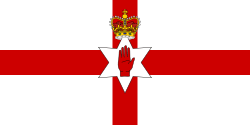
The Union Jack has been the flag of the United Kingdom since 1801. It is derived by combining Saint George's Cross (for England), St Andrew's Cross (for Scotland) and Saint Patrick's Saltire. St Patrick's saltire has been used as a symbol of Ireland since the 1780s.
The flag of Ireland is a tricolour of green, white and orange, first flown in 1848. The colours stand for Irish Catholicism, Irish Protestantism, and peace between the two.
Although it was originally intended as a symbol of peace and ecumenism, the tricolour is today seen by Irish unionists as a symbol of Irish republicanism and the Irish Republican Army. Many other flags are suggested as the cross-border flag for Ireland.
The flag of Northern Ireland (Ulster Banner) was used officially between 1953 and 1973.
Motto
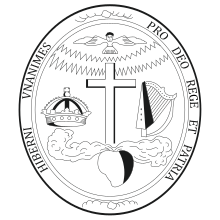
The Republic of Ireland has no national motto. Northern Ireland has used the motto Quis separabit?, Latin from Romans 8:35: Quis nos separabit a caritate Christi..., "Who shall separate us from the love of Christ?"
The motto Hiberni Unanimes pro Deo Rege et Patria ("The Irish United for God, King, and Country") was used by Confederate Ireland.[1]
The Society of United Irishmen (1780s–1798) used Equality: it is new strung and shall be heard as a motto.[2]
Flora and fauna
Bird
The northern lapwing (Vanellus vanellus) was declared the Republic of Ireland's national bird by a committee of the Irish Wildlife Conservancy in 1990.[3]
Northern Ireland does not have an official national bird, but the Eurasian oystercatcher (Haematopus ostralegus) was unofficially selected in 1961.[4][5]
The Irish Examiner has put the rook (Corvus frugilegus) forward as a possible national bird, due to their "wild hardiness, spirit, and resilience, in the face of all difficulties, and their ability to cope with style and a bit of craic, with anything that the world throws at them."[6]
In 2016 Niall Hatch of BirdWatch Ireland listed ten possible national birds: European robin, peregrine falcon, common house martin, Eurasian curlew, roseate tern, barn owl, common swift, Bohemian waxwing, Eurasian blackcap, northern pintail.[7][8]
Dog breed
The Irish wolfhound is generally considered Ireland's national breed, although some, including Michael Collins, have put forward the Kerry Blue Terrier as an alternative.[9][10][11][12]
Fish
The northern pike (Esox lucius) is Northern Ireland's national fish.[13]
"Coarse fish" have been described as the Republic of Ireland's national fish; this category includes the likes of bream, perch and carp.[14]
Domesticated mammal
Sheep and cattle are widely used as symbols of Ireland. Sheep feature commonly in souvenirs sold to tourists,[15][16] while cattle have been important in Irish mythology and folklore for centuries, as sources of milk, cheese, leather and beef, as well as social status. Cattle feature in the Táin Bó Cúailnge and Táin Bó Flidhais, and the tale of Glas Gaibhnenn.[17][18]
Wild mammal
The national land mammal/animal is unclear. The Irish hare (Lepus timidus) has been described as a national animal,[19] as has the red deer (Cervus elaphus).[20]
Plant and flower
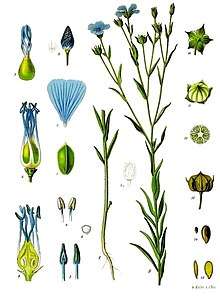
The national plant is the shamrock (Trifolium dubium or Trifolium repens).
Fuchsia magellanica 'Riccartonii' (hummingbird fuchsia, hardy fuchsia; in Irish deora Dé, "tears of God")[21] has sometimes been described as the national flower, despite not being a native plant.[22][23]
Flax (Linum usitatissimum) is widely used as an emblem of Northern Ireland, such as in the emblem of the Northern Ireland Assembly, referencing Ulster's linen industry.
Tree
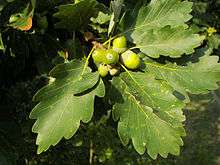
The national tree of the Republic is the sessile oak (Quercus petraea), declared as such in 1990 by Taoiseach Charlie Haughey.[24][25]
Other accounts give the strawberry tree (Arbutus unedo) as the national tree.[26]
Culture
Dance
Irish dance is Ireland's national dance.
Instrument
The Celtic harp (cláirseach), great Irish warpipes (píob mhór) and uilleann pipes have all been described as national musical instruments.
National anthem
"Amhrán na bhFiann" ("The Soldiers' Song") is the national anthem of the Republic of Ireland. Written in English by Peadar Kearney and set to music by Patrick Heeney in 1907, it was translated to Irish by Liam Ó Rinn in 1923; the Irish-language version is considered the official anthem. "God Save Ireland" was used from the 1870s until independence.
"God Save The Queen/King" is commonly used by Northern Ireland, as is the Londonderry Air.
"Ireland's Call" has been used by the Ireland national rugby union team and others since 1995.
Personifications
There are several national personifications, all female:
- Hibernia, an attractive, vulnerable girl
- Erin
- Kathleen Ní Houlihan
- The Sean-Bhean bhocht: a poor old woman who needs the help of young Irish men willing to fight and die to free Ireland
- Banba, Fódla and Ériu, three goddesses
- Róisín Dubh (Dark Little Rose)
Poet
Thomas Moore (1779–1852) and W. B. Yeats (1865–1939) are both considered the national poet.
Other
Drink
Irish breakfast tea is described as the national (non-alcoholic) drink.[27][28]
Among alcoholic drinks, Irish whiskey is the national spirit, with Jameson Irish Whiskey and Tullamore Dew the main whiskey brands.[29]
Poitín, made from potatoes and with an alcohol content of up to 90% ABV, is the traditional Irish moonshine,[30] brewed illegally since 1661, when a duty was placed on whiskey and other spirits were made illegal. According to one guidebook, "If you see a product labelled "poteen" in an airport or a bar, it's simply a white duty-paid Irish schnapps. By definition, poteen is illegal and can't be sold."[31]
Stout, a dark beer made using roasted oats or barley, is the national beer, with Guinness heavily promoted as a symbol of Ireland.[32] [33][32][34][33]
Stout was largely unknown in Ireland when Arthur Guinness opened his brewery in 1759; the traditional beer was Irish red ale.[35][36]
Irish coffee, made with coffee, whiskey, sugar and cream and invented in Foynes in 1943, has been described as the national cocktail.[37]
Food

The national dish of Ireland is the Irish stew; other national dishes include the full Irish breakfast/Ulster fry and bacon and cabbage.[38]
Gemstone
The national gemstone is Connemara / Conamara marble.[39]
Patron saint
Saint Patrick, a 5th-century bishop born in Britain, is Ireland's patron saint.
Sport
Gaelic games constitute Ireland's national sports: Gaelic football, ladies' Gaelic football, hurling, camogie, rounders and Gaelic handball.
Irish road bowling (bullets) is another Irish sport.
Weapon
Gerald of Wales saw the battle axe as Ireland's national weapon.[40]
References
- ↑ Stokes, George Thomas 1843-1898 (27 August 2016). "IRELAND & THE ANGLO-NORMAN CHU". WENTWORTH Press – via Google Books.
- ↑ McLaughlin, John A. (4 April 2003). "One green hill: journeys through Irish songs". Beyond the Pale – via Google Books.
- ↑ "Lapwing's tricolour feathers fit the bill". Irish Independent.
- ↑ "Poll to find first national bird for Britain". BBC News. 16 March 2015 – via www.bbc.com.
- ↑ "National Bird Campaign".
- ↑ "Cormac MacConnell: Worthy candidates to be our national bird". Irish Examiner. 10 November 2016.
- ↑ "Who should lead our national flock?". Irish Independent.
- ↑ "We love the reliant robin, but will high-flying wren rule roost?". Irish Independent.
- ↑ "Irish dogs and Irish writers".
- ↑ "The National Dog of Ireland". 17 March 2009.
- ↑ "An Irishman's Diary".
- ↑ "Is the Kerry Blue Terrier the National Dog of Ireland? - USKBTC".
- ↑ Minahan, James (23 December 2009). "The Complete Guide to National Symbols and Emblems [2 Volumes]". ABC-CLIO – via Google Books.
- ↑ Minahan, James (23 December 2009). "The Complete Guide to National Symbols and Emblems [2 Volumes]". ABC-CLIO – via Google Books.
- ↑ "Shamrock, sheep, leprechauns: how we'll be remembered?".
- ↑ "When in Ireland, we brake for Sheep!". 9 August 2016.
- ↑ Sherwood, Amy (23 June 2018). "An Bó Bheannaithe: Cattle Symbolism in Traditional Irish Folklore, Myth, and Archaeology". McNair Scholars Online Journal. 3 (1): 189–225. doi:10.15760/mcnair.2009.189.
- ↑ "Cows in Irish tradition and the Cattle Raid of Cooley". 20 July 2014.
- ↑ "Is the hare our national animal?". Irish Examiner. 19 November 2007.
- ↑ "Red Deer: The National Animal of Ireland". 9 August 2016.
- ↑ design, Coded web. "Wildflower Fuchsia Irish Wild Flora Wildflowers of Ireland". www.wildflowersofireland.net. Retrieved 7 September 2017.
- ↑ McInerney, Monica (18 September 2009). "Those Faraday Girls". Pan Macmillan. Retrieved 7 September 2017 – via Google Books.
- ↑ "Tossing their heads in sprightly dance". Irish Independent. Retrieved 7 September 2017.
- ↑ "The oak, our national tree, and the plunders of our natural forests - Politico".
- ↑ "Ardagh Village - History and Information".
- ↑ "Fighting the SOD that kills our national tree".
- ↑ Walsh, Fergus (7 October 2015). "Irish breakfast tea: Ireland's other national drink - The Irish Place".
- ↑ "IRISH TEA".
- ↑ "Irish Whiskey Brands". The Ireland Whiskey Trail. 2014. Retrieved 8 September 2017.
- ↑ Leigh, Richard (1 October 2006). "Erceldoune & Other Stories". Lulu.com – via Google Books.
- ↑ DK (1 May 2008). "Whisky". Dorling Kindersley Limited – via Google Books.
- 1 2 "Drinking Beer in Ireland - dummies".
- 1 2 Fodor's (29 March 2011). "Fodor's Dublin and Southeastern Ireland". Travel Distribution – via Google Books.
- ↑ Gauldie, Robin (1 May 2008). "GLOBETROTTER Travel Guide IRELAND". New Holland Publishers – via Google Books.
- ↑ "Guinness Pint Index, Price, Historical Prices Ireland - Finfacts Ireland". www.finfacts.ie.
- ↑ Frost, Michael (1 August 2006). "Exiles: Living Missionally in a Post-Christian Culture". Baker Books – via Google Books.
- ↑ Punch. "PUNCH - Irish Coffee".
- ↑ Ryan, Susan. "National food survey unveils Ireland's favourite dish".
- ↑ Itineraries. "15 things you didn't know about Ireland".
- ↑ "Weaponry: How to Kill your Enemy and Defend yourself in Viking-Age Ireland - Battle of Clontarf". dh.tcd.ie.
